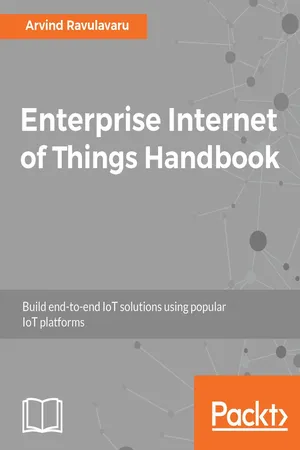
- 332 pages
- English
- ePUB (mobile friendly)
- Available on iOS & Android
Enterprise Internet of Things Handbook
About This Book
Get familiar with the building blocks of IoT solutions using off–the-shelf IoT platforms.About This Book• Work with various trending IoT platforms such as AWS IoT, Azure IoT, Google IoT, IBM Watson IoT, and Kaa IoT• Gain hands-on knowledge working with Cloud-based IoT platforms, IoT Analytics, and so on.• A practical guide that will help you build IoT strategies for your organizationWho This Book Is ForThis book is targeted at IoT architects and engineers, or any stakeholders working with IoT solutions in an organization. This book will also help decision makers and professionals from small- and medium-sized enterprises build an IoT strategy for their venture.What You Will Learn• Connect a Temperature and Humidity sensor and see how these two can be managed from various platforms• Explore the core components of AWS IoT such as AWS Kinesis and AWS IoTRules Engine• Build a simple analysis dashboard using Azure IoT and Power BI• Understand the fundamentals of Google IoT and use Google core APIs to build your own dashboard• Get started and work with the IBM Watson IoT platform• Integrate Cassandra and Zeppelin with Kaa IoT dashboard• Review some Machine Learning and AI and get to know more about their implementation in the IoT domain.In DetailThere is a lot of work that is being done in the IoT domain and according to Forbes the global IoT market will grow from $157B in 2016 to $457B by 2020. This is an amazing market both in terms technology advancement as well as money.In this book, we will be covering five popular IoT platforms, namely, AWS IoT, Microsoft Azure IoT, Google IoT Core, IBM Watson IoT, and Kaa IoT middleware. You are going to build solutions that will use a Raspberry Pi 3, a DHT11 Temperature and humidity sensor, and a dashboard to visualize the sensor data in real-time. Furthermore, you will also explore various components of each of the platforms that are needed to achieve the desired solution.Besides building solutions, you will look at how Machine Learning and IoT go hand in hand and later design a simple predictive web service based on this concept. By the end of this book, you will be in a position to implement an IoT strategy best-fit for your organizationStyle and approachAn informative guide that will help you design and implement an IoT Strategy best-fit for your organization
Frequently asked questions
Information
Kaa IoT
- Kaa IoT architecture
- Setting up an end-to-end solution using Kaa IoT
- Setting up a visualization dashboard for the solution using ThingsBoard
Kaa IoT
- Active load balancing
- Configuration management
- Data collection
- Endpoint provisioning and registration
- Events
- Notifications
How does Kaa work?

Designing a sample application
Solution
Architecture

End-to-end communication
- Download VirtualBox
- Download the Kaa image
- Set up Kaa
- Create an application
- Set up data and a configuration schema
- Set up REST appenders
- Download SDK
- Set up the Raspberry Pi and DHT11
- Set up the client app and publish the data
- Set up a Node.js server
- View incoming data from the device
Data visualization
- Create a ThingsBoard demo account
- Create a new device
- Set up the REST log appender to post data to ThingsBoard
- Build the required dashboard
Pricing
Table of contents
- Title Page
- Copyright and Credits
- Packt Upsell
- Contributors
- Preface
- Introduction to IoT
- Applications of IoT
- Getting Started with IoT Platforms
- AWS IoT
- Azure IoT
- Google Cloud IoT
- IBM Watson IoT
- Kaa IoT
- IoT and Machine Learning
- Platform Comparisons
- Other Books You May Enjoy